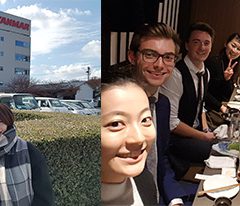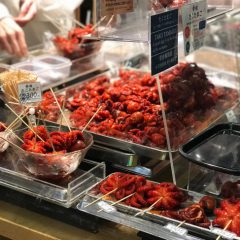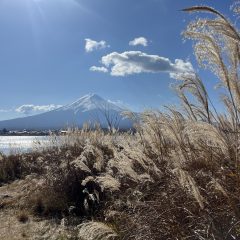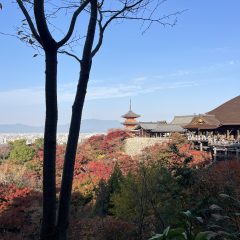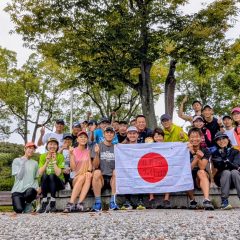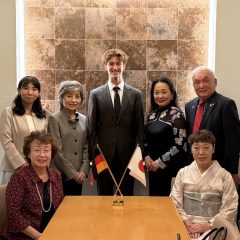☆☆☆Sixth Report of Christoph Jetter, 16th scholarship holder of Grünwald foundation☆☆☆

Wow, time passed so quickly in Japan. I basically was busy every single day and gained a lot of experiences as well as I got to know interesting people and worked diligently. The last two weeks of my stay in Japan I spent travelling with the Japan Rail Pass. First, I discovered the south of Japan (Kyushu) followed by a trip to Tokyo and its surrounding. Ahead of my travels I was keen about the cultural, personal and scenic differences.
The first destinations I visited were Hiroshima and Nagasaki. Both were the scene for a worldwide outstanding, negative incident – The atomic bomb at the end of World war II in 1945. The American bombs were named “Little Boy” and “Fat Man” and ensured a lot of destruction, deaths, diseases and recognition within the worldwide community. Both cities know about their importance as warning signal. This is why they prepared the history in several ways to make it accessible for everybody who visits the cities. It is also not that easy to walk through both cities without recognising its historical relevance. This incident still shapes the cityscape as well as the people living there. The people are very open minded when it comes to their history, are willed to have a chat and are very well educated when it comes to details of the war. I also recognised that people are interested in my opinion which I got asked for several times during my visit, either in coffee shops or randomly when doing grocery shopping. Within this occasion I was able to talk to Mito Kosei, one of a few who survived the attack in 1945. He wrote down his personal experiences in a book which offers a lot of information which was not present in any of the public museums. This experience shaped me lasting as well as it sharpened my mind when it comes to world politics, atomic weapons and conflicts of interests.

Independently of their history both cities are worth a visit. In Hiroshima there is the famous Island called Miyajima, beautiful gardens and museums. Especially, the Shukkein garden is very beautiful and you can find the only tree which survive the atomic bomb attack there. Even nowadays, its seeds are sent around the world to spread a sign of peace. Within this garden I meet a very polite man from London who I talked to for about two hours about Japan, world politics, the challenges for the future and a lot more. A very special encounter. Out of both cities, Nagasaki is the less touristic one as well as the atomic incident is not as present as in Hiroshima. Also, Nagasaki is more internationally influence and therefore less shaped by the Japanese culture. Because of the booming port, Nagasaki was a famous place of trading in the past. Therefore, people from Portugal and the Netherlands had their separate quarter for trading within Nagasaki, which can still be visited today. This might also be the reason why there are many international restaurants present in Nagasaki. Also, English is way more popular than in other parts in Japan. Nagasaki is located within a lot of mountains which makes it a nice spot for hiking, daytrips and a nice view from above the city during the night.

When heading towards Kumamoto I recognised that I left the touristic paths. When living in Kansai I was used to get asked by strangers if I would be up for a picture, however when I moved further south, I experienced a new level of requests. Until today I am not sure why this is the case because European people are not rare in Japan even though you could find less in Kyushu. I also figured out that the relationship of the people to the surrounding nature improves the more I leave the large cities. This might also be the case because it is necessary to take care of yourself since the number of active volcanoes increases the further south I went. Actually, I wanted to hike up the worldwide largest crater of an active volcano (Mount Aso) in Kumamoto. Unfortunately, the increased volcanic activity did not allow this trip. Interestingly the water temperature surrounding the volcano is warmer which is why fish and other seafood has more food available. Therefore, the local food is characterised by a lot of seafood. A highlight of Kumamoto is the Suizen-ji garden which represents the 53 stops of the Tokaido-Shinkansen line.
In Kagoshima I finally was able to hike up on a volcano. However, it is prohibited to climb to the top of Mount Sakurajima, since it is one of the most active volcanoes worldwide. Daily, smoke is rising from the volcano located just a few kilometres ahead of the city centre. It is a very special scenery seeing the volcano being placed in the middle of Kagoshima bay. Even though the danger of the volcano erupting is constantly present, 600.000 people live close by. Therefore, hot springs and free foot baths are located all over the city centre. My personal impression was that people in the south of Japan are more relaxed and live a less stressful life in comparison to the people living in the Kansai area. However, I recognised a less present Japanese influence and an increased internationality within the city. I think this might be the case due to the large distance to Kyoto (the former capital of Japan) as well as Tokyo, the current capital which are both locations representing a lot of the Japanese culture. Also, south Japan is known of several revolutions and their international influence.

Together with a very good friend from Taiwan, which I know from my studies in Great Britain, I spent one week in Tokyo. The world’s largest metropole offered me a totally new experience of Japan. As expected, Toyko was bigger, louder, and faster than other cities I have been before. However, I experienced Tokyo to get more into extremes then other cities of Japan. For Example, there are a lot of very rich people in Tokyo but on the other hand, I saw more homeless people than anywhere else in Japan. Also, each district differs significantly for others. There is a special business district, an entertainment district, an electric town and so on. I also recognised that people try to stand out more. Crazy clothes, strange coloured hair, noticeably looks and cars can be seen everywhere. In general, more people are able to speak English which might be because of the percentage of foreigners. Therefore, customer service and the politeness of people, for Japanese standards, suffers.

Tokyo does not offer a lot of classic sightseeing, however getting to know the different districts is even more fun. Also, the world’s largest fish market, the highest building of Japan, famous temples and shrines as well as the imperial palace can be visited. I especially enjoyed the variety of world class bars and restaurants as well as the city itself by night. For Europeans, the rush hour in Tokyo is a unique experience as well. For me personally, Tokyo is a city that has to be experienced by participating in the daily life by visiting restaurants and Izakaya’s as well as getting in contact with the locals, rather than usual sightseeing. Additionally, Tokyo offers a lot of interesting spots in the surrounding.

I highly recommend a daytrip to Nikko, a city in the mountains close to Tokyo, which is considered as world heritage due to its stunning Temples. The city is contemplative and impressive at the same time. Also, the first impression of the city does not look like it has a hidden city of temples in the forests.

The next daytrip we went to Japans most iconic landmark, Mount Fuji. We were very lucky to see Fuji-San without clouds and we had perfect conditions. The inactive volcano stands out because of its shape, its height and appears mystic. Because of heavy rain the day before, Mount Fuji was covered in snow. In my opinion, Japanese people are rightly proud of their landmark because it is incredible to actually see it. Therefore, it was a special moment for me. It is for sure that I will climb Fuji-San when visiting Japan, the next time.

Before heading back to Osaka to have a final dinner with my friends from Rotact I stopped by Kamakura and Yokohama. In Kamakura its political and cultural importance in the past can be seen. Especially, because of several influential Temples and Shrines. The most famous spot is the great Budda (Kotoku-In). Kamakura also offers an outstanding view on beach, surfers and Fuji-San at the same time. On the other hand, Yokohama seems to be strongly influenced by foreigners. A huge China town and several European restaurants and offers specially tailored for tourists prove that. This might be the case due to the cities large harbour and the short distance to Tokyo.

Concluding I would like to thank everyone who got engaged during my three months stay in Japan. First of all, Mr. Okamoto and his wife as well as the Rotary Club Grünwald. Additionally, I would like to thank my friends and colleges who made my time in Japan very special and valuable. The experiences I gained through the Grünwald-Scholarship are unique and will shape me on a long-term basis.
During my stay I got to know a new culture intensively and gained new perspectives which allowed for questioning processes and structures. I was also able to participate within the Japanese work life as well as learn a new language. Additionally, I personally developed which allows to approach upcoming challenges with an improved set of experiences. Besides my demanding everyday life and intense work, I was also able to meet new people, to participate in an exchange of cultures and to develop my personal opinion about Japan as well as travel the country.
The entire experience was possible because Mr. Okamoto invests a lot of time and energy into his scholarship holders. He also constantly improves his scholarship and promotes intercultural exchange. I am very pleased that I was not just able to develop myself further due to Mr. Okamoto’s foundation, but I also found a good friend and a mentor in him. I want to express my gratitude once more that I was able to spend three unforgettable months in Japan which will shape my further life journey.

